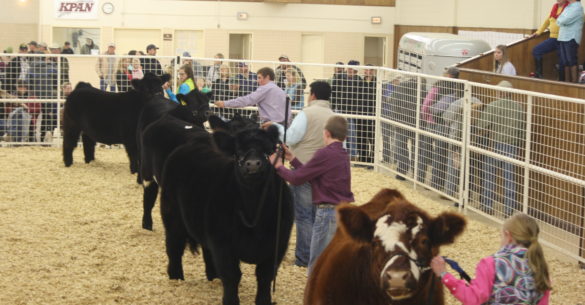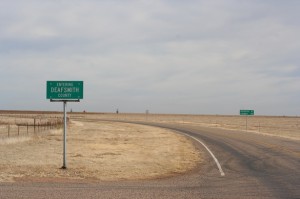Welcome to Deaf Smith County Deaf Smith County, on the western edge of the Panhandle, is bounded on the west by New Mexico, on the north by Oldham County, on the east by Randall County, and on the south by Parmer and Castro counties. It was named for Erastus “Deaf” Smith, a famous scout of the Texas Revolution.
The county’s center point is at 102°30′ west longitude and 35°00′ north latitude. Deaf Smith County comprises approximately 1,497 square miles of level prairies and rolling plains on the western edge of the Llano Estacado. Its loam soils, ranging from deep chocolate to sandy, support 00 feet above sea level; the minimum average temperature is 22° F in January, and the average annual maximum is 93° in July. The average annual rainfall is 17.37 inches, and the annual growing season averages 185 days.
The western prairies were home to Plains Apaches, Comanches and Kiowas who were forced out in the the Indian wars of the 1870s. Shortly thereafter ranchers began to appear in the area, and in 1876 the Texas legislature formed Deaf Smith County from the Bexar District.
By the early 1880s, large ranches, such as the T Anchor Ranch and the sprawling XIT, dominated the county. The coming of the railroad also brought forth a new town, Hereford, which quickly outstripped the other local hamlets. As a result Hereford became the county seat after an election on November 8, 1898. By 1900, the county had 97 ranches and farms and a population of 843.
Between 1900 and 1910 the large ranchers began to sell their lands, and land-company promotions brought a rush of settlers to the area. With them came significant changes in the local agricultural economy during the first half of the twentieth century. The number of farms and ranches in the county increased steadily, with acreage being sewn with wheat, sorghum and corn. The expansive underground aquifer was tapped by more than 400 windmills in the growing city of Hereford.
In 1910, the County Courthouse was built in Hereford and is the only marble courthouse standing in the state of Texas.
Vegetable production was introduced on a large scale, and processing and packing plants for onions, potatoes, and other perishable vegetables were also established. In 1964 the Holly Sugar Company opened its $20 million mill and refinery, which was in operation for 34 years.
Cattle feeding also began to flourish in the 1960s with the opening of several feedlots that used primarily locally-grown grain. By the 1970s these lots were bringing 80 percent of the county’s $230 million annual average income. In the late 1980s the county led the state in numbers of cattle fed; it often led the nation in this category. The establishment of feedlots brought commercial production of corn and the establishment of several meat-packing plants in the county.
Large-scale irrigation in the 1950s further encouraged the expansion of farming. The labor needs of the farming economy drew large numbers of migrant laborers, mostly Hispanic, to the county’s packing sheds. As this labor force grew, it became less migratory, and increasing numbers of Mexican Americans moved into the area permanently. By 2008, more than 60 percent of the county’s population was of Hispanic descent.
With a population of 18,501, Deaf Smith County contains the communities of Dawn, Glenrio, Westway and Hereford, the only urban center. Hereford is host to eight public schools, three private schools, a local branch of Amarillo College, a hospital, museum, library, YMCA, Aquatic Center, and golf course.
Today, cattle feeding is Hereford’s main industry and the city calls itself the “Cattle Capital of the World.” There are more than three million cattle fed within a 50-mile radius of Hereford, which is nestled in a large grain-producing area where farming is abundant. Dairy production in the county increased dramatically in 2008, when Deaf Smith County ranked in the state’s top five in milk production. These three agribusiness industries provide the economic base for the county.
- Forage Information & Research
- Emergency Preparedness
- Consumer Information Center
- Children’s Health
- American Diabetes Association
- National Cancer Institute




